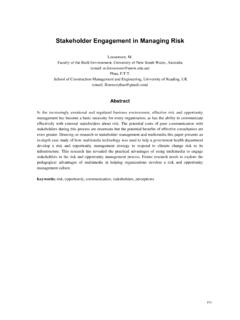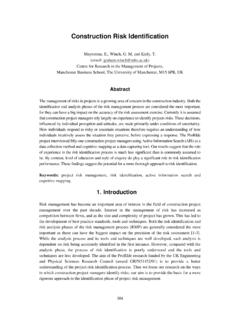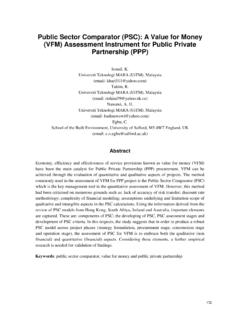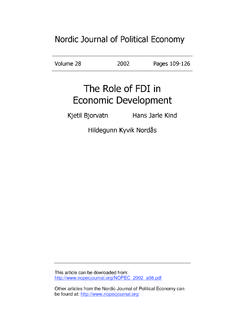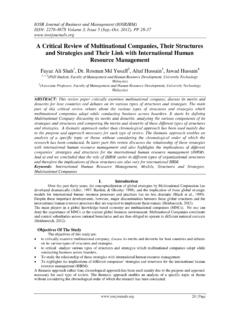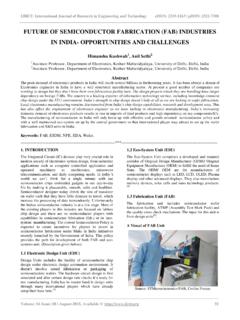Transcription of An Assessment of the Build - Operate - Transfer (BOT ...
1 An Assessment of the Build - Operate - Transfer (BOT) model for Infrastructure project financing in tanzania N M LEMA, University of Dar es Salaam P. O. Box 35131, Dar es Salaam, tanzania Abstract Build - Operate - Transfer (BOT), as a means of applying private capital to infrastructure development, has gained more and more attention from the governments. The main reasons for this are as follows: first, the governments try to tap the activity and creativeness of the private sectors by means of BOT, improve efficiency and productive forces by interest drive and settle the ubiquitous problems of the inefficiency in the operation of infrastructure; second, the governments attempt to solve the problem of the capital shortage by means of BOT in the case of financial deterioration and the weakening of investment ability; last, public works and public facilities could be shifted to the track of private-ownership by means of BOT.
2 This paper makes a critical Assessment of the BOT concept with major focus on identifying possible issues that need special consideration and attention in the course of adopting the BOT model in tanzania . In addition, an Assessment of the current status of affairs with respect to environment conducive for BOT project is made. This paper is based on a questionnaire survey of key technical officials in the government. The paper concludes that the BOT model could be used as a mechanism to provide opportunity to finance infrastructure projects. However, the paper suggests some necessary preparatory measures. Firstly, BOT legal and regulatory framework has to be put in place with the intention to protect and guide investors, the government and users tailored for BOT projects from start to finish.
3 Such policy should incorporate probable solutions that will address most of the issues that have been identified in this paper. Secondly, for successful implementation of the BOT strategy, a credible and efficient administrative framework has to be ensured. It may require set up of an institution to handle the BOT projects. Thirdly, creation of awareness among all stakeholders is an important preparatory measure. Seminars, campaigns, and other deliberate efforts to educate the public on the BOT concepts and their effects are extremely crucial for smooth adoption among the public at large. Fourthly, long and short-term training, study tours, and on-job training of personnel tailored to handle BOT projects are important aspects for the long-term capacity building.
4 Key words: Infrastructure; Private Sector participation; policies; Build - Operate - Transfer . INTRODUCTION Investing in public infrastructure such as roads, bridges, ports, power plants, and public utilities has traditionally been the responsibility of governments, both in capitalist and socialist economies. Governments have been using tax revenue and/or loans from commercial banks or international finance institutions such as the World Bank to fund infrastructure investments. Given the current economic states of many developing countries and in order for governments to maintain adequate investments in infrastructure, an enormous burden is placed on public finances.
5 Developing countries now spend around US$200 billion a year on infrastructure investment, of which more than 90 per cent is government-sponsored (Pahlman, 1996). Faced with increased economic constraints on capital spending, reduced borrowing capacity and the need to service debts, the Government of tanzania (GOT) has been exploring ways to enhance its key infrastructure projects and has stated that it is to adopt the BOT model (Ngumbulu, et al., 1998). Build - Operate - Transfer (BOT) is a relatively new approach to infrastructure development, which enables direct private sector investment in large-scale projects such as roads, irrigation, telecommunication, bridges and power plants. According to the United Nations Commission on International Trade Law, (UNCITRAL) BOT is also increasingly being utilized for medium and small-scale projects (UNIDO, 1996).
6 In its basic form, a BOT project is one in which a government grants a concession for a pre-determined period of time to a private consortium to Build , Operate and manage the project . The consortium recoups its investment costs and profit through charges or tolls (such as road tolls or electricity sales). At the end of the concession period, the project is transferred to the government at such a state and conditions as stipulated in a predetermined contract agreement. Objectives This paper therefore presents a summary of a study performed to assess the BOT concept to identifying possible issues that may require special consideration in the course of adopting the model in tanzania .
7 The study performed addressed the following objectives: General experiences on the BOT concept worldwide have been documented; BOT project proposals in tanzania have been explored and probable areas that could suit the BOT model have been identified; Issues that may need attention before adopting the BOT model have been identified; and The study has finally suggested some countermeasures to enable smooth adoption of the model . The paper presents views and opinions based on literature survey as well as opinions obtained from relevant technical people, economists, potential road users and officers concerned with legal and policy issues from various relevant institutions. BOT Projects Although the term Build - Operate - Transfer is relatively new, the practice of permitting private concerns to develop and Operate infrastructure projects has been around for several years.
8 By October 1992, there had been over 70 projects valued at USD 30 Billion in 14 countries that had been financed since mid 1980 s. At least another 100 projects in 33 countries (mostly in Europe) worth USD 160 Billion were identified as being in some stage of planning or development. In Europe, such projects were called Concessions . The government, in such projects would establish the major objective of a particular project and assume the role of defender of the public interest, but would allow a private company or consortium to design, finance, construct and Operate the particular project for a certain concession period. The concessionaire would assume responsibility for the completeness of design, any risks associated with construction, and the control of operational costs, all of which would be recouped through the collection of revenue from those benefiting from the use of the finished project .
9 The concessionaire would be granted a specific concession period, after which time the contract might be renewed at the option of the government, or title would be transferred from the concessionaire to the government or government agency (Levy, 1996). The basic principle that makes BOT projects work is that of a "bankable franchise". In other words if a facility has the potential to generate sufficient revenues to cover both its capital and operating costs plus a competitive rate of return to investors. If the private team proposing the project can negotiate an acceptable long-term franchise agreement, then private capital in form of debt and equity can be raised to Build the project (Poole and Sugimoto, 1993).
10 Due to the fact that BOT concept is relatively a new approach to infrastructure development, a number of questions may be asked such as: Can BOT be suitable for tanzania now? How best can we adopt BOT in tanzania ? What kinds of projects are best suited for BOT model ? Can we really benefit from BOT model ? Does the government have an institutional capacity and capability to handle BOT? Is BOT legal framework in place? Such questions needed to be addressed as the GOT looks forward to adopting BOT model . It is therefore the objective of this paper to present results of a survey conducted in an attempt to respond to the questions raised above. Survey Methodology A number of techniques were used to accomplish the study.



